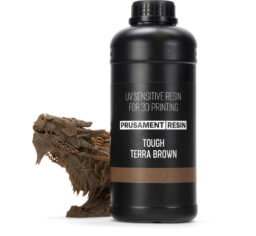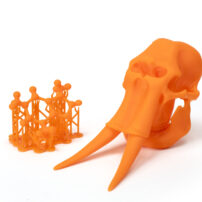
Prusament Resin Tough
Tough resin is the most commonly used MSLA material. It’s very strong, easy to print, and allows printing extremely detailed parts. Tough resins are being used mostly for printing tiny parts with great detail, for example, plastic models, action figures, jewelry, various prototypes, etc.
Characteristics
Pros
- Print reliability
- Short exposure time (1,6 - 2,4s)
- Great print detail
- Good deformation resistance
- Low odor
- Low health impact
- Does not contain Bisphenol A
Cons
- Non-recyclable material
- Uncured resin might pose a health risk
- Low temperature resistance (50 °C)
Application
Model & hobby
With Prusament Tough Resin, you can produce prints with an amazing level of detail, which makes this material perfect for tiny and detailed action models, prototypes, and large project accessories. Cured material can be easily sanded, both dry and wet.
Rapid prototyping
Short exposure time and the perfect level of detail make the MSLA technology ideal for small and detailed prototypes that can’t be produced with FFF/FDM printers. Plus, the overall MSLA printing time is shorter than with FFF/FDM.
Casting molds
Prusament Tough Resin can be used for making both simple and more complex molds. You can either print a master model (you can make a mold from it) or you can print the mold itself, for example for casting silicone.
Education models
Low odor, easy usage, and low health impact make Prusament Tough Resin great for printing detailed educational models.
Details
- Print difficulty
- Easy / Medium
- Exposure time
- 1.6 - 2.4s
- With SL1S SPEED
- Toughness
- Average
- Odor
- Low
- Transparency
- Translucent in thin layers
- Heat resistance
- 50 °C
- Curing
- 5 min with CW1
- Post processing
- Easy
- Detail
- High
Prusament Tough Resin offers good toughness, high printing speeds, an excellent level of detail, and low health risks to the user. It is the most frequently used MSLA material due to its price and how easy it is to print with it. The vast majority of users print with tough resins at home, in a workroom, making various detailed parts, such as railway models, action figures, jewelry, various prototypes, etc. Prusament Tough Resin fulfills the need for easy and comfortable home usage because our resins are designed to have low odor, and the lowest health risk possible. Our in-house produced resin does not contain Bisphenol-A and other dangerous chemicals but is still easy to use, offering amazing accuracy and a high level of details. Prusament Tough Resin is suitable for both beginners and experienced users.
Download Safety Data Sheet Prusa Orange (PDF)
Download Safety Data Sheet Rich Black (PDF)
Download Safety Data Sheet Anthracite Grey (PDF)
Available colors
Beginners tips & tricks
Hollowing the model
Use a Hollowing function in PrusaSlicer to save a considerable amount of material. Don’t forget to create two holes so the resin can be poured out and to counter the vacuum effect during printing.
Sanding
When post-processing tough resin, it’s possible to use both dry and wet sanding.
Printing with the Original Prusa SL1S SPEED
Prusament Resin is fully compatible with third-party MSLA 3D printers. However, it was tailor-made for the Original Prusa SL1S SPEED. In combination with SL1S, you’ll get astonishing speed without losing any print details! Thanks to the monochromatic display and fast tilt mechanism it’s possible to print with exposure as short as 1.6 – 2.4s per layer, depending on the object size and complexity! SL1S SPEED will help you make models with amazing details and much quicker than with other machines, FFF/FDM printers included!
Manipulation with Resin
- Shake well before use.
- Always use protective equipment. Wear rubber gloves, consider using a half-mask or respirator and avoid direct contact with skin.
- Wash your skin with water after any direct contact with liquid resin.
- Not fit for human consumption! Avoid contact with children and animals.
- The liquid resin may cause an allergic reaction. Seek medical assistance in case of any health issues.
- Use isopropyl alcohol (90% or higher) to wash printed models.
Waste disposal
Uncured resin leftovers should be disposed of with other dangerous chemicals at places designated for them. Liquid resin cannot be recycled and definitely should not end in general waste. The same rule applies to bottles, paper towels, and models stained with liquid (uncured) resin. However, cured resin (reactoplastic material) is, unlike filaments (thermoplastic material), a non-recyclable material – it belongs in the general waste.
Prusament Resin was created as a part of the project Photopolymer resins for 3D printing technology (FW01010650), financed with support from Technology Agency of the Czech Republic and Ministry of industry and trade, as a part of Program TREND.


























